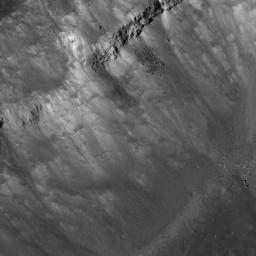
|
Kepler’s Rim
- Click the image above for a larger view
- Full-Res JPEG (1000 x 1000) (90.3 kB)
- Full-Res TIFF (1000 x 1000) (1.0 MB)
Caption:
Steep interior wall of Kepler crater, rim is to the upper left and the bottom of the crater is in the lower right. Note the exposed layering near the top, and the boulders collecting at the base of the crater wall. LROC NAC M107128381R, image width is 800 meters (2625 feet).
Landslides are primarily caused by gravity pulling loose material down a slope. Numerous factors contribute to landslides on Earth, including water and vegetation, but these can be ignored for the Moon. However, both bodies are affected by the angle of repose which is related to the cohesiveness of the material making up the slope. Once the angle of repose is exceeded the loose material on the slope slides downhill. Since the exposed bedrock layer near the top of the wall is more cohesive it stays intact while loose rocks and dust slide from underneath. As the wall material continues to slide down, more of the resistant layer will be exposed until it is undermined and is pulled down by gravity. The boulders at the base of the landslides are probably pieces of the bedrock layer.
Background Info:
NASA's Goddard Space Flight Center built and manages the mission for the Exploration Systems Mission Directorate at NASA Headquarters in Washington. The Lunar Reconnaissance Orbiter Camera was designed to acquire data for landing site certification and to conduct polar illumination studies and global mapping. Operated by Arizona State University, LROC consists of a pair of narrow-angle cameras (NAC) and a single wide-angle camera (WAC). The mission is expected to return over 70 terabytes of image data.
Cataloging Keywords:
| Name | Value | Additional Values |
|---|---|---|
| Target | Moon | |
| System | Earth | |
| Target Type | Satellite | |
| Mission | Lunar Reconnaissance Orbiter (LRO) | |
| Instrument Host | Lunar Reconnaissance Orbiter | |
| Host Type | Orbiter | |
| Instrument | Lunar Reconnaissance Orbiter Camera (NAC) | |
| Detector | Narrow Angle Camera (NAC), Wide Angle Camera (WAC) | |
| Extra Keywords | Crater, Dust, Grayscale, Water | |
| Acquisition Date | ||
| Release Date | 2010-11-10 | |
| Date in Caption | ||
| Image Credit | NASA/GSFC/Arizona State University | |
| Source | photojournal.jpl.nasa.gov/catalog/PIA13681 | |
| Identifier | PIA13681 | |
